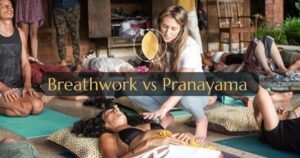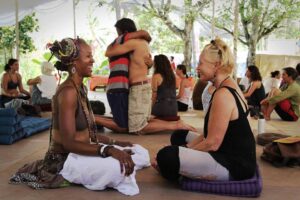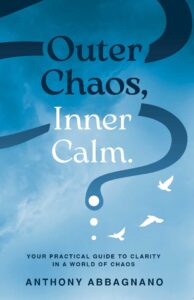‘Breathwork’ is rapidly growing in popularity and along with its growth has come a lot of confusion as to what exactly it is. The confusion stems in large part from the term itself, as it can mean many things. Some take the term at face value, and think it is working with the breath for functional reasons – such as to learn how to breathe ‘better.’ This interpretation can lead to some cheeky responses when invited to a ‘Breathwork’ session, such as: “I already know how to breathe, I’ve been doing it my whole life!” Other people immediately think of yogic breathing practices or Pranayama; or breathing exercises they’ve been taught to reduce anxiety or induce sleep. These people aren’t wrong, however, ‘Breathwork’ is also the official term used to describe Conscious, Connected Breathwork, or CCB.
With all these different ways of working with the breath sharing the same title, it can be really confusing to decipher which is which and what they each aim to do. So we have outlined the distinguishing factors of each below. For the purpose of reducing confusion we will refer to Conscious, Connected Breathwork as ‘CCB’ (even though most people just call it “Breathwork”), and we will refer to other breath practices as ‘breath work’.
Conscious Connected Breathwork, or CCB
The term ‘Breathwork’ without a space between ‘breath’ and ‘work’ is the official term used to describe all variants of Conscious, Connected Breathwork (CCB); and this is the practice that has seen a major boom in popularity over the past 5 years. All CCB variants stem from two major branches of modern Breathwork which were born in the 1960’s – Holotropic and Rebirthing (if you would like to find out more about The History of Modern Breathwork, click here). While the methods, environment, and tools used differ among CCB variants, they all share the technique of having no pause between the inhale and exhale.
Keeping the breath connected leads to non-ordinary states of mind with alterations of consciousness that can feel quite similar to psychedelics and plant medicine. Every CCB session is different for every person, every time, and the breath is the guide, taking you exactly where you need to go for your highest healing. Some benefits reported by breathers include the shedding of trauma, spiritual connectivity, breakthrough insights, physical healing, connections with the divine or deceased loved ones, more self love, increased happiness and presence, better relationships, and an acceleration of awakening.
CCB sessions are typically between 30 to 120 minutes in length, and maintaining a deep and connected breath for such a long duration can be difficult on your own. As a result, you will find most CCB is done with a facilitator, who is there to coach you on the technique, encourage you to keep with it, and hold space for the deep inner journey that CCB brings you on.
CCB is the type of Breathwork that Alchemy of Breath offers, and if you see an advertisement for a ‘Breathwork Journey,’ or a class that mentions altering your consciousness, then this is likely what is being facilitated. Some well-known variants of CCB include: Transformational Breathwork, Transformations Breathwork, Integrative Breathwork, Radiance Breathwork, Biodynamic Breathwork, The Wim Hof Method, Clarity Breathwork, Liberation Breathwork, Quantum Light Breath, and Breath of Bliss.
Breathwork vs Pranayama

Pranayama is an ancient yogic breath practice. Prana in Sanskrit is “life force energy” and Ayama refers to expansion, extension, regulation and control. Through controlling the breath, the mind is controlled and Prana is directed. Pranayama is a practice to prepare for meditation and is very purifying. There are several types of pranayama that have different intentions but they all originate from the ancient text – ‘The Yoga Sutras’.
Worth noting, Yoga and Tantra teachers sometimes refer to Pranayama breath practices as ‘Breathwork,’ however Pranayama is the most accurate term and calling it breathwork can create confusion. Having said that, if you see an advertisement for a “Yoga and Breathwork,” “Tantra and Breathwork,” or “Kundalini and Breathwork” class then it is most likely Pranayama and not CCB that is being offered.
CCB and Pranayama come from a different lineage and they have different intentions. CCB brings you on a deep inner journey while you are doing it and it is about letting go, whereas Pranayama is less about a deep inner journey and more about breath and mind control. Also, CCB is typically done lying down, with eyes closed, and yogic breath practices are often done sitting up straight.
Functional Breath Work
Functional breathing teachings and practices are also sometimes just referred to as breathwork, however the technique, goal, and outcome is very different from CCB. Functional breathing is typically taught in order to help people learn how to breathe deeper or more effectively. This is important as most of us have not breathed properly since we were babies, and we are breathing in a constricted way and failing to use the full capacity of our lungs or over breathing (see Buteyko for more on this). This leads to alterations of CO2 and oxygen levels which can negatively affect every system in the body, and contribute to disease.
Learning how to breathe properly with functional breath work can not only provide you with better overall health, more energy and a greater sense of mental clarity, it can also help you sleep and digest food better, improve your body’s immune response, and reduce stress and anxiety.
Breath Work Practices or Exercises
Breath practices and exercises are also sometimes referred to as Breathwork, and they involve manipulating the breath in various ways in order to alter your physical, mental, or emotional state. They differ from CCB because they are typically much shorter in duration (some as short as one minute), they do not alter your consciousness, and are not typically used for transformation, spiritual awakening, or deep emotional healing. They also do not require a facilitator, and are usually self-guided.
There is an endless array of breath practices available, many of which overlap with Pranayama and functional breath work. Research shows breath practices can produce immediate benefits with different techniques leading to different effects. Some of the most common effects include reducing stress and anxiety, inducing sleep, or increasing energy, focus, or performance.
Closing Thoughts
Working with the breath is not something new, the breath has played an essential role throughout history, and it is deeply embedded in most cultures and religions. There are countless ways of working with the breath available to us, and all variants are of value and worthy of exploration!
If you are interested in experiencing the alchemy of Conscious, Connected, Breathwork then we invite you to join us at our free weekly Sunday #BreathetheWorld gatherings and Tuesday Ceremonial Breathwork gatherings. We also host a variety of special live events where we combine inquiry with longer duration Breathworks for deeply transformative outcomes, and you can find out about our upcoming live events here.





